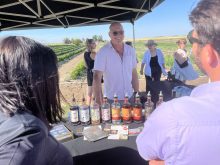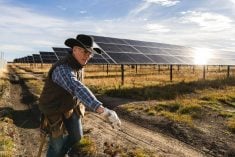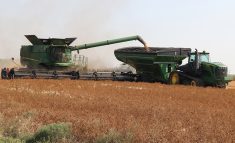TULLIBY LAKE, Alta. – Stan and Dorothy Walterhouse quit raising cattle
twice before they were named the cattle producers of the year in
November 2000 by the Lloydminster exhibition association.
In 1978, their herd of 243 was destroyed after one cow was diagnosed
with brucellosis. It was a year before they could have cattle on their
18 quarters that roll down to the North Saskatchewan River.
Then, in 1991, the Walterhouses attempted a semi retirement by
splitting their land and 300 head with their two sons who ranch near
Read Also

Alberta honey business ‘thrives’ despite bumpy beginnings
Thrive Honey showcases its honey production in market where Alberta produces 40 per cent of all honey produced in the country
them today.
But the herd has gradually grown and today they have 150 head including
cows, yearling heifers and newborn calves.
Stan and Dorothy said it was a surprise when the fair board called them
up to say they had been given the honour.
The Walterhouses are not in the purebred business, they don’t show
their animals and have never judged cattle at competitions. But they
had won the respect of their neighbours and regular customers, first
for their steers and now for the bred heifers they sell each fall.
“Stan is a heavy culler,” said Dorothy.
Good cattle are not wild and have a little length on them, said Stan
when asked what he likes.
“Once I look at an animal, I know it. I don’t have favourites. If
they’re good, they’re all good.”
Out in the pens are Hereford cross cattle with white faces. Most of
this spring’s calves are playing in the sun and on the straw covering
the nursery corral. Nearby are the yearling heifers that will be bred
and sold this fall.
Stan’s father carved this ranch out of the brush and trees, but he died
when Stan was 13. Stan then farmed to support his mother and younger
siblings.
In 1959, three years after his mother remarried, Stan and Dorothy
married and took over the ranch starting with 12 head of cattle, nine
horses and the S bar W brand. They also grew livestock feed, canola,
wheat, oats and barley. Besides the commercial cattle herd, there was a
farrow-to-finish pig operation and milk cows that allowed them to ship
cream until the late 1970s. They had no electricity or running water
until 1969 when they built the house they still live in.
Their four children, two sons and two daughters, were in 4-H through
the years. It is a testament to their parents’ success that the kids
saw agriculture as a good occupation and all are on farms or ranches
today. Among the Walterhouses’ six grandchildren may be another
ranching generation.
The Walterhouses’ experience has been recognized by more than the
Lloydminster fair board. Dorothy was secretary of the Tulliby Lake ag
society for 20 years.
Stan was an adviser for 12 years to the Onion Lake Indian Reserve and
is on the board of the 53-year-old Lea Park cattle sale, held every
September. He remembers trailing the first load of steers to the sale
in 1949, eight kilometres down the road.
Dorothy finds a small black handwritten notebook and scans through it
to locate their best cattle prices. In 1993 they got an average of
$1,050 per steer, or $1.04 a pound for their grass-fed animals.
The road in front of their house was paved six years ago to accommodate
the oil and gas industry. It is too busy now to use to move their
cattle by horse as they used too, said Stan.
Other changes Dorothy has noticed in their years here are the clearing
of brush, the absence of neighbours and the drop in the number of kids
in Tulliby Lake school from about 90 when theirs went, to a third of
that today.
The drought dried up their dugouts and if that happens this summer,
they will have to pump water from the river. They also note how tough
it is to make a dollar on grain. They are not worried about the
livestock side. Someone has to raise the calves for the industry, said
Dorothy.
“I like working,” said Stan, when asked if he’ll retire.
Dorothy agreed. “He’s more or less doing what he likes to do,” with
fewer cattle, less cropping and only three horses.
Stan and Dorothy’s relationship is affectionate. When Dorothy said she
keeps a diary, Stan jokes that “it solves a lot of arguments.”
They agree that farming has become a two-income job, requiring one of
the adults to have off-farm work. But that means losing the teamwork
that the Walterhouses have. Dorothy helps with the feeding in the
morning and when the cows need TLC, she’s there.
“It takes two to make her go,” said Stan. “You only make one
partnership in your life – that’s marriage.”
Although Stan had a hired man for many years and also worked with his
sons, he said too many farm partnerships don’t work out because of hard
feelings. Someone has to be the boss, but then the others may not learn
how to call the shots if they are always following orders.
Stan laughs when asked what makes a good farmer. He said it’s lots of
ambition, hard work and management.
“And be prepared to accept what Mother Nature gives you.”
















